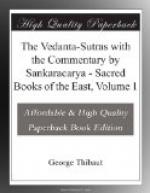Notes:
[Footnote 16: All the mentioned modes of Brahman are known from Scripture only, not from ordinary experience. If the latter were the case, then, and then only, Scripture might at first refer to them ‘anuvadena,’ and finally negative them.]
[Footnote 17: Ramanuja has here some strong remarks on the improbability of qualities emphatically attributed to Brahman, in more than one passage, having to be set aside in any meditation: ’Na ka matapit/ri/sahasrebhyo-pi vatsalatara/m/ sastra/m/ pratarakavad aparamarthikau nirasaniyau gu/n/au prama/n/antarapratipannau adare/n/opadi/s/ya sa/m/sara/k/akraparivartanena purvam eva bambhramyamanan mumukshun bhuyo-pi bhramayitum alam.’]
[Footnote 18: The Sri-bh-ashya as well as several other commentaries reads tadbhavabhavitvat for San@kara’s tadbhavabhavitvat.]
Adhikara/n/a I (1, 2).—The meditation on the Atman enjoined by Scripture is not an act to be accomplished once only, but is to be repeated again and again.
Adhik. II (3).—The devotee engaged in meditation on Brahman is to view it as constituting his own Self.
Adhik. III (4).—To the rule laid down in the preceding adhikara/n/a the so-called pratikopasanas, i.e. those meditations in which Brahman is viewed under a symbol or outward manifestation (as, for instance, mano brahmety upasita) constitute an exception, i.e. the devotee is not to consider the pratika as constituting his own Self.
Adhik. IV (5).—In the pratikopasanas the pratika is to be meditatively viewed as being one with Brahman, not Brahman as being one with the pratika.—Ramanuja takes Sutra 5 as simply giving a reason for the decision arrived at under Sutra 4, and therefore as not constituting a new adhikara/n/a.
Adhik. V (6).—In meditations connected with constitutives of sacrificial works (as, for instance, ya evasau tapati tam udgitham upasita) the idea of the divinity, &c. is to be transferred to the sacrificial item, not vice versa. In the example quoted, for instance, the udgitha is to be viewed as Aditya, not Aditya as the udgitha.
Adhik. VI (7-10).—The devotee is to carry on his meditations in a sitting posture.—Sa@nkara maintains that this rule does not apply to those meditations whose result is sa/m/yagdar/s/ana; but the Sutra gives no hint to that effect.
Adhik. VII (11).—The meditations may be carried on at any time, and in any place, favourable to concentration of mind.
Adhik. VIII (12).—The meditations are to be continued until death.—Sa@nkara again maintains that those meditations which lead to sa/m/yagdar/s/ana are excepted.
Adhik. IX (13).—When through those meditations the knowledge of Brahman has been reached, the vidvan is no longer affected by the consequences of either past or future evil deeds.




